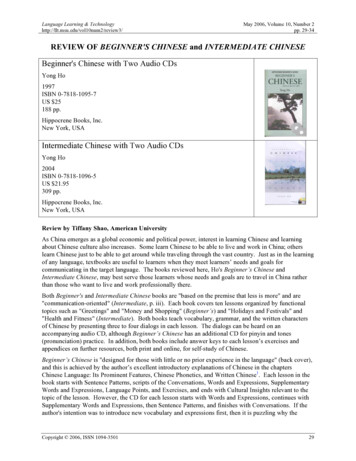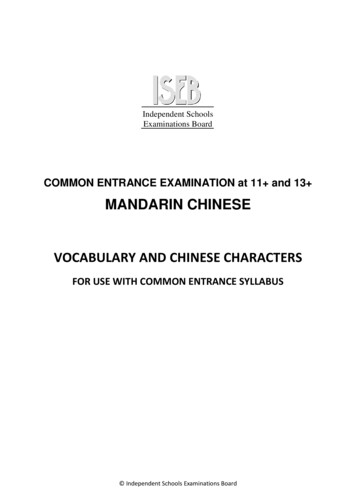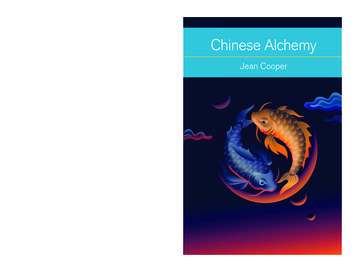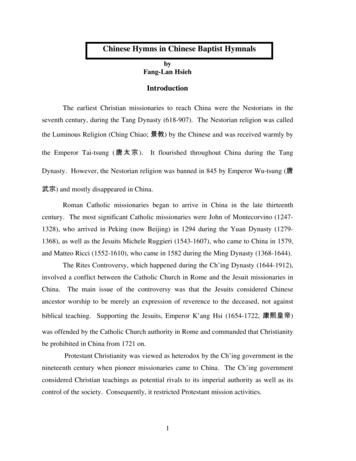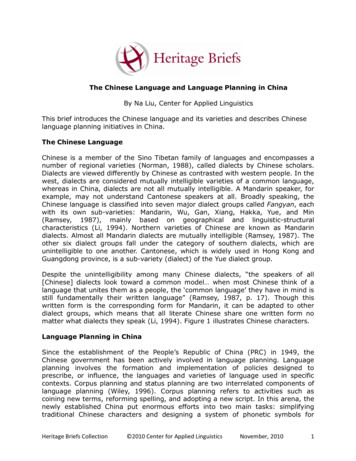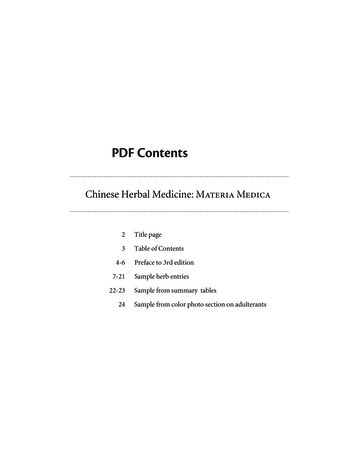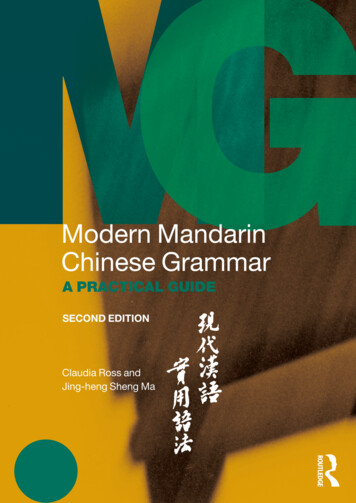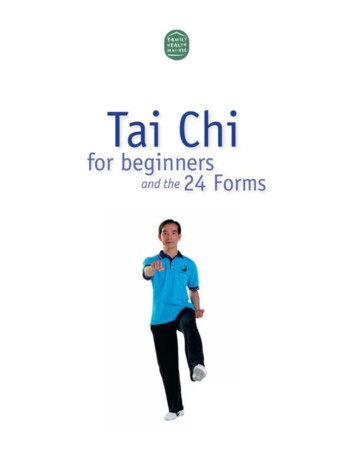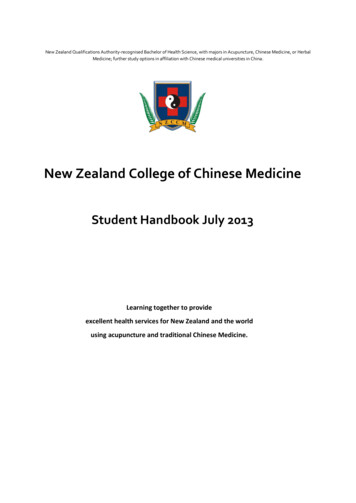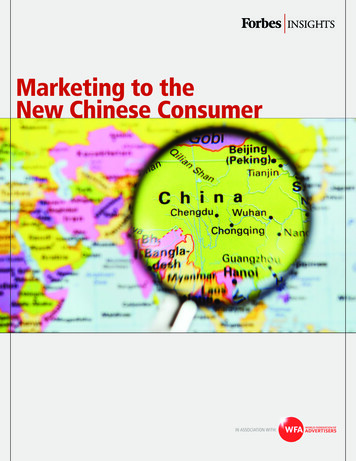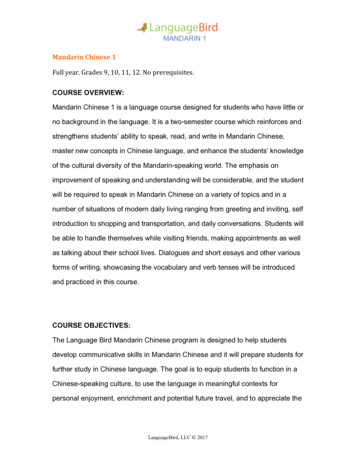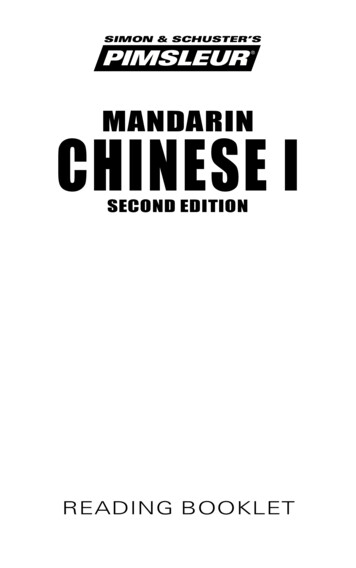
Transcription
International Journal of Humanities Social Sciences and Education (IJHSSE)Volume 4, Issue 3, March 2017, PP 59-66ISSN 2349-0373 (Print) & ISSN 2349-0381 07www.arcjournals.orgA Study on Chinese Traditional Culture Education in China’sKindergartensJinling Tao1*, Jianjun Yin212College of Education Science, NanTong University, China.College of Education Science, Yangzhou University, China.Abstract: This study investigated the current situations of the Chinese traditional culture education in China’skindergartens. A total of nine hundred 900 teachers from different ranked kindergartens in six province and onemunicipality were selected for questionnaires, on-site observation and interviews. The education practices in theseven kindergartens of the two cities were observed on sites. The students and their parents or grandparentswere interviewed. This study demonstrated that the concept of Chinese traditional culture education is not clearamong the groups selected for study; the teachers are not well versed in Chinese traditional culture; theeducation activities lack diversity; and the integrality of the education is weak. In order to develop the Chinesetraditional culture education, it was recommended that the concept of traditional culture education should beestablished academically; the goal of the education should be set appropriately; a rich content of the educationshould be selected and the diverse resources of traditional culture education should be integrated.Keywords: Chinese kindergartens; Traditional culture, Traditional culture education1. INTRODUCTIONTraditional culture is a nation’s creation in the real life and its accretion in a long history. Itdemonstrates the life style and the value system of the nation. It is the symbol of the spiritual life ofmany generations. It is the outcome of the nation’s great effort to harmoniously live with the natureand historical environment in long history. Every nation has its own traditional culture, which is thesymbol of the nation and the basis of the nation’s existence. The traditional culture provides a crucialelement for the nation’s development as a unity. However, the traditional cultures of many nations allover the world are facing the risk of extinction under the pressure of the growth of the modern culture.The culture gaps between different generations appear in many nations. Eduard Spranger noted thatthe task of education is to pass down culture, experience cultural value and cultivate the persons whoare able to create cultural value [1]. In the book Education and Culture, E. Spranger claimed thateducation is a cultural process and proposed the only solution for cultural crisis [2]. He believedhuman is a cultural being. Human’s history is the history of culture. Therefore, the process ofeducation is a procedure of the cultural development in history. Kindergarten education is theenlightenment and the foundation in people’s lives. Its impact on the students lasts for a whole life.Thus, it is necessary to create rich and diverse experiences of traditional culture for the students andplant the seed of traditional culture in their hearts so that they may pass on the legacy of the traditionalculture.2. SAMPLE AND METHOD2.1. SampleRandomly stratified sampling method was applied to select the kindergartens as samples from sixprovinces and one municipality such as J province and S province. The selected samples includedurban kindergartens, urban-rural integrated kindergartens and rural kindergartens which took up to48.8%, 13.4% and 37.8% of the total number of the samples, respectively. Among them, 60.2%kindergartens are ranked as province-model, 30.5% as city-model, and 9.3% as normal level. Nine ARCPage 59
Jinling Tao & Jianjun Yinhundred teachers of these kindergartens received questionnaires. And 864 questionnaires werecollected. Among them, 840 questionnaires were applicable and used in this study. The rate ofeffective collection of the questionnaires reached 93.3%. Among the selected teachers, only three aremale, and all of others are female. And 23.7% of them are under 25 years old; 22.4% are between 26to 30 years old; 9.3% are between 30 to 40 years old; 8.5% are between 41 to 50 years old; 2.8% areabove 50 years old. Regarding to their education levels, 35.4% have Bachelor’s Degrees; 56.5% havecollege diplomas; and 8.1% have been just high school educated. Regarding to their major, 81.3% ofthem majored in preschool education; 8.9% did not graduate from preschool education major butother majors in education field; and 9.8% graduated from non-education majors. The activities oftraditional culture education in seven kindergartens in N city and F city were observed. After theactivities, some of the parents, grandparents, and the students of middle classes and top classes wereinterviewed.2.2. Method2.2.1. Questionnaires were used to collect the information of the kindergartens (e.g. names, features,ranks), the teachers (genders, education levels, class grades, years of teaching, titles, etc.), andthe activities of traditional culture education (goal, content, method, means, frequency, etc.).2.2.2. On-site observation was conducted. In order to know the current situations of the education, theactivities of traditional culture education in seven kindergartens in NanTong, WeiFang andNanJing cities were observed on site but without participation.2.2.3. Interviews with the teachers, the parents and grandparents of the students were accomplishedthrough internet, phone and face to face conversation, in order to know their knowledge ontraditional culture education. In addition, the students in middle classes and top classes wereinterviewed immediately after the activities.2.3. Statistical AnalysisThe SPSS 19.0 was used to analyze the collected questionnaires to obtain the percentages of thedescriptive statistical results. The interviews with teachers, parents, grandparents and students wereanalyzed. The designs of the activities, records of observations and the products of the students whichwere made in the activities were analyzed as well.3. RESULT3.1. The Concept of Traditional Culture Education is not ClearIn the questionnaires, 53.7% of the teachers believed the traditional festival customs are highlybeneficial to the growth of children; 40.2% of them believed the customs are averagely beneficial; 6.1%of them believed they are just normally good. None of them believed they are not beneficial at all ornot so beneficial. Regarding to other traditional culture items, most of the teachers believed they areaveragely beneficial. Through the interviews, it is known that many teachers and parents did notclearly or accurately understand the value of traditional culture education. They emphasized on theknowledge and skills of traditional culture but neglected the importance of the affectional influence ofthe traditional culture. Some parents considered traditional culture education as “the restoration ofhistory”, “reading ancient poems and books”, “learning traditional manners”, etc. On-site observationof the activities also confirmed the conclusion that people usually believed knowledge is moreimportant than affectional experiences. Therefore, teachers and parents did not correctly understandthe traditional culture education in kindergartens. The goal of traditional culture education should beclarified.3.2. The Teachers are not Well Versed in Chinese Traditional CultureThe teachers’ understanding on twenty-five traditional cultural items, which are cataloged into fourgroups: traditional customs, traditional literature, traditional arts and traditional sports, were studied.48.4% of the teachers have rich knowledge on traditional customs but only have basic understandingon other items. In the interviews, most of the teachers claimed they never received systematic andspecialized training on traditional culture education. Even though they think they have basisunderstanding on some traditional cultural items, they are unable to conduct the education on thoseitems because they are short of practical experiences. In the interviews with grandparents and parents,International Journal of Humanities Social Sciences and Education (IJHSSE)Page 60
A Study on Chinese Traditional Culture Education in China’s Kindergartensit is obvious that grandparents know much more traditional culture and are more interested in it thanthe parents. The study reveals that the teachers are not very well versed in traditional Chinese culture.They lack basic knowledge and skills of traditional culture; know little on the deeper concept oftraditional culture. Therefore, the development of education activities is hindered. So their ability ofconducting traditional culture education need to be improved.3.3. The Education Activities Lack DiversityThe application frequency of twenty-five traditional cultural items, which are cataloged into fourgroups: traditional customs, traditional literature, traditional arts and traditional physical trainings,were studied. 54.1% of the teacher most frequently applied traditional festival customs as theireducation items. However, all of the other twenty-four items, such as folk opera, folk stories, and folktoys and so on, are not applied often. The interviews with teachers, parents and grandparentsdemonstrated the education activities lack diversity, which is in accordance with the conclusion of thequestionnaires. The Lantern Festival, Dragon Boat Festival, Mid-autumn Festival, are the mosteducated festivals. Even though Spring Festival is the most important festival in Chinese traditionalculture, it is not the primary selection of teachers. The education contents should be diversified.3.4. The Integration of the Education is WeakThe questionnaires showed that 89.4% of the traditional culture education activities are held inkindergartens, 7.8% are in homes, and only 2.8% are in public cultural facilities such as communitymuseums and theaters. The same result can be found through the on-site observations and interviews.Kindergarten is the only one major resource of traditional culture education. However, other resourcessuch as homes, communities, museum, culture clubs, theaters, are not used sufficiently and thus donot play its functions very well in traditional culture education. These resources should be used infuture.4. DISCUSSIONS AND RECOMMENDATIONSThe National Ministry of Education issued the Complete Excellent Chinese Traditional CultureGuidance in 2014, in which it was noted that it is so important and urgent to strengthen the excellentChinese traditional culture education and the guidance to improve the education is also put forward.General Office of The Communist Party of China Central Committee and General Office of the StateCouncil issued the Opinions on The Implementation of The Chinese Traditional Culture HeritageDevelopment Project, in which early childhood education is categorized into the field of traditionalculture education. In this paper, the suggestions to the traditional culture education in kindergartensare proposed as below.4.1. Recommendations: Establish the Academic Concept of Traditional Culture EducationThe process of education is the formation of students’ personalities in culture. Culture is thefoundation of education. Education is the key of the preservation of culture. German educatorFriedrich Adolph Wilhelm Diesterweg, influenced by Johann Heinrich Pestalozzi’s educational theoryof naturalism, proposed that social culture should be concerned in education besides the Principle ofNatural Adaptability which was proposed by the former educator. He believed education should notonly match the children’s physical and psychological development but also accord with the socialculture, especially its national culture and local culture [3, 4]. The curriculum in kindergartens is theselected and organized contents with the integrated and helpful experiences for a clear purpose basedon the features of children’s physical and psychological development and the background of socialculture [5]. Educators should select the best from their rich cultural accumulation; meanwhile, theselected contents also should match the learning abilities of children. In this way, the text ofkindergartens curriculum may be formed [6]. Traditional culture is a nation’s creation and accretion inreal lives in a long history. It demonstrates the life style and the value system of the nation. It is thesymbol of the spiritual life of many generations. It is the outcome of the nation’s great efforts toharmoniously live with the nature and historical environment in a long history. Traditional culturebelongs to the nation and to the world as well.Under the trend of globalization and the impact of foreign culture and commercial culture, theinheritance and continuity of good traditional culture is in crisis and must be concerned. ConsideringInternational Journal of Humanities Social Sciences and Education (IJHSSE)Page 61
Jinling Tao & Jianjun Yinthe dislocation of the traditional culture, early childhood education as the enlightenment of lives hasthe obligation to spread the concept of national culture and awaken the nation’s awareness of theinheritance of traditional culture. Educators should realize the responsibility and make great efforts todevelopment their own knowledge of traditional culture and the ability of educating traditional culture.They should rationally analyze and select the contents for the purpose of children’s development andconsistently create new ideas and methods with a worldly broad mind regarding to traditional culture.Thus, they will establish open-minded and advanced concept of traditional culture education, andhave the capability to fulfill the responsibility and mission of spreading, inheriting and promoting thegood traditional culture elements.4.2. Set an Appropriate Goal of Traditional Culture EducationTraditional culture education is not an addition of the existing courses, but the reconstruction of thecourses from a new perspective. The reconstructed kindergarten courses are harmony, which is inconsistent to the harmony development of children. The education goal is the starting point and end ofeducation. The process from the possibility of the goal to its feasibility is a process of integrationdistribution-integration. It is a harmony unity of hierarchy and integration. It is not only thespecialization and distribution in a single field, but also the gradual development of many fields as aunity. It does not only emphasize the knowledge and skills but also focuses on the influence oftraditional culture on children’s emotion and attitudes. Traditional culture education in kindergartensis not aimed at teaching knowledge or skills of traditional culture, but to experience the affectionalconnotation, share the joy from traditional culture and establish the identification and confidence withtraditional culture through diverse activities. The goal of the traditional culture education inkindergartens should be set for the development of children according to their ages and personalities.It is not right to use a single standard upon all children. Instead, the goal should be different fromperson to person. Taking the dragon dance in the Lantern Festival as an example, the purpose is notonly to teach the knowledge and grasp the skills about dragon dance, but also to understand the spiritof national unity and cooperation which is demonstrated by dragon dance. Taking traditional festivalactivities as another example, educator can use the most typical and well-known customs as aneducated content. However, primary classes may emphasize on participating in the activity andexperience the festival environment; middle classes may emphasize on understanding the deepconnotation of the festival; the top classes may create and enrich the activities. The goals of theclasses become gradually deeper according to the students’ ages. The students not only know theknowledge and grasp the skills but also understand the national mind, moral ethics, spirit, value andaesthetic. Therefore, the national confidence and culture pride will be arose through understanding thenation’s wisdom. BoTong Street Elementary School in WeiFang city is a good example. The LanternFestival was educated in this school. The primary class students were taught to make rice dumpling sothat they may taste the food of the Lantern Festival; middle class students were taught to makecolored lantern and other decorations so that they may develop their carefulness and patience andenjoy the beauty of the colored lantern; the top class students were taught to make land boat anddragon lantern with recycled material and organized the program of running the land boats and dragondance so that they may develop their creativity and understand the culture connation of the festival.International Journal of Humanities Social Sciences and Education (IJHSSE)Page 62
A Study on Chinese Traditional Culture Education in China’s KindergartensDragon Dance4.3. Rich Educated Contents should be EmbracedChinese traditional culture is very rich and broad. For example, there are traditional customs andtraditions (e.g. marriage customs, festivals, and the tradition of respecting the elders), traditional folkarts (e.g. folk arts, crafts and sculptures), folk music (e.g. folk songs, dances and operas), folkliteratures (e.g. folk poems, stories and legends), folk sports (e.g. folk games, Kong Fu, and physicalcompetition) and so on. All of the Chinese traditional culture elements demonstrate regional andnational diversity and unity as well. This diversity and unity can be found in Yue Ju of Zhe Jiang, YuJu of He Nan, Huangmeixi of An Hui, Lu Ju of Shanghai, Er Ren Tai of Neimenggu, Er Ren Zhuan ofNortheast, Ci Xiu of Su Zhou, Ni Ren of Wu Xi, Bian Zhu of Si chuan, Zi Sha Hu of Yi Xing, Ci Qiof Jingdezhen, Bu Long of Han Zu, Long Deng of Tong Zu, Wen Shi of North, Wu Shi of South, andso on. Traditional culture education in kindergartens has the solid foundation of national culture, andshould be appropriate for the development of children. The educators should exploit the richtraditional culture resources. Considering the feasibility and possibility of the education practice, theeducators should select the proper and good resources. In this way, the curriculums would bedeveloped based on the current situations, interests and the need of students and also is appropriate tothe schools, classes, local resources and individuals. Thus, traditional culture education would be apart of children’s lives. The classes would show unity and integration. They cover many filed ofeducation and make good balance. Such education would demonstrate the features of nationality,enlightenment, fun and scientificity. For example, the folk games Ding Niu, Dou Jiao, Tai Hua Jiao,Chao Huangdou, Fan Hong Sheng, Tiao Pi Jin, Gun Tie Huan, are all attractive to children and lovedby them. For another example, Beijing opera, which is known as the quintessence of Chinese nationalculture, is a comprehensive art. It has rich and deep culture basis. Its facial masks, costume, stageproperty, the four performing techniques and good stories can be used to build up a comprehensiveInternational Journal of Humanities Social Sciences and Education (IJHSSE)Page 63
Jinling Tao & Jianjun Yinclass network, which shows the beautify of the contents, singing styles, costumes, makeup and stageproperty to the students. In Xinhua Kindergarten, WeiFang City, the teacher Jingdong Ji who has thetalent of singing Beijing opera, taught the class “Little Opera Fans”, which was incorporated withwatching opera, learning opera, drawing facial masks and making tools in the classes. The classesstimulated the interests and passion of the students on Beijing opera. Another teacher, Yujing Xv, whohas experiences of running land boat, organized a series of activities of the Lantern Festival bymaking land boat, dragon lantern and dragon dancing.Making Land BoatsRunning Land Boats4.4. The Diverse Resources of Traditional Culture Education should be Integrated4.3.1. The educators should review and categorize Chinese traditional culture items, investigate andcollect good cultural heritages. Then, the proper traditional culture items may be selected tobuild up a data base of traditional culture resources, which would be a reference for traditionalculture education in kindergartens.4.3.2.Professional education training should be offered to the teachers before they go to work andafter they have some working experiences. The teachers may go out of school to be trained bysome experts, or some experts may be invited to schools to train teachers. In addition, humanresources in the society should be encouraged and invited to participate in school’s educationprograms. Some parents and residents in the community who have talents in traditional culture,folk artists or heritage inheritor can be hired by kindergartens as the advisers of traditionalInternational Journal of Humanities Social Sciences and Education (IJHSSE)Page 64
A Study on Chinese Traditional Culture Education in China’s Kindergartensculture education. In this way the human resources of traditional culture education may beenriched. For example, Mehuashanzhuang Kindergarten invited Shadow Play troupe to theschool to make the Shadow Play tools and play the drams for the students. Moreover, the troupetrained two teachers of the kindergarten to be the Heritage Inheritor of Shadow Play. Xinhuakindergarten in WeiFang city invited a masseur to do massage for students. BaoTong StreetKindergarten in WeiFang city invited experts on Chinese medicine to teach students torecognize Chinese traditional medicines in a plantation. DiJing Kindergarten in WeiFang cityinvited Chinese calligraphers to participate in the Spring Festival activities to write the Chineseletter of blessing and paste spring couplets with students.4.3.3. A system incorporated with kindergartens, families, communities, protection centers ofIntangible Cultural Heritage, and literary federation should be established. In this way, allresources can be integrated and used. Folk artists, talents, heritage inheritors should be invitedto participated in traditional culture education. The circles of traditional culture education,exhibitions and shows of traditional culture should be built up through the establishment ofmuseums, culture clubs, theaters and Intangible Cultural Heritage centers. Diverse educationbasis would be formed, which is a system incorporated with families, communities,kindergartens.Incorporated system of traditional culture education in kindergartensVisitation in Kite MuseumMaking KitesKindergartens can invite experts of traditional culture to do some seminars to help parents understandthe background, the meaning of the traditional culture education so that the parents may cultivate anatmosphere of traditional culture at their homes. The parents who have some talents in some aspectsof traditional culture may be invited to participate in the design, preparation and practice of educationInternational Journal of Humanities Social Sciences and Education (IJHSSE)Page 65
Jinling Tao & Jianjun Yinand promotion the traditional culture. For example, some parents may collect the folk games forschools. In the kite festival, parents may make kites, play kites with their children together. Residentsin the communities around kindergartens may be invited to contribute their abilities and talents oftraditional culture to the school’s education. In this way, people understand and care traditionalculture education much more. The education thus reaches the families and society. Also, students maygo out from school into communities, museums, theaters, and families to conduct the activities oftraditional culture. Through the real and vivid experiences, students understand the connectionbetween the traditional culture and people’s daily life. Education in kindergartens, education in familyand education in society should be incorporated together. Kindergarten is still the main educationbasis. But families and society could in greater efforts support the major role of kindergarten. In thisway, education resources are integrated. Kindergarten, families and society are united in traditionalculture education.ACKNOWLEDGEMENTShandong Province Social Science Planning Research Project "Research on the Inheritance ofChinese Excellent Traditional Culture in Kindergarten from the Perspective of Educational Ecology“15CWHJ04”REFERENCES[1] Jinhong Ding. The Foundation of Pedagogy. Beijing: Higher Education Press, 2009: 13, 14.[2] Rongchang Zhao, Jizheng Zhang. Foreign Education on the election. Nanjing: Jiangsu EducationPress, 1990:285.[3] Diesterweg. The German Teacher Training Guide. Yuan Yiying translation. Beijing: People'sEducation Press, 2001:169.[4] Yongping Yu. On kindergarten curriculum and its characteristics. Early education, 2001(1).[5] Yongping Yu. Culture, folk art and kindergarten curriculum [J]. Pre-school curriculum research,2001(1).AUTHORS’ BIOGRAPHYJinling Tao, Ph.D, is an associate professor of education in the College of EducationScience at Nantong University. She directs thesis for master level students and herareas of research includes preschool curricula and preschool instructional theory. Shecan be reached by email at tjling2000@yeah.netJianjun Yin, Ph.D, is a guest professor of education in the College of EducationScience in Yangzhou University. He holds permanent professorship at Jackson StateUniversity. He can be reached at jianjun.yin@jsums.eduInternational Journal of Humanities Social Sciences and Education (IJHSSE)Page 66
Some parents considered traditional culture education as “the restoration of history”, “reading ancient poems and books”, “learning traditional manners”, etc. On-site observation of the activities also confirmed the conclusion that people usually believed know
